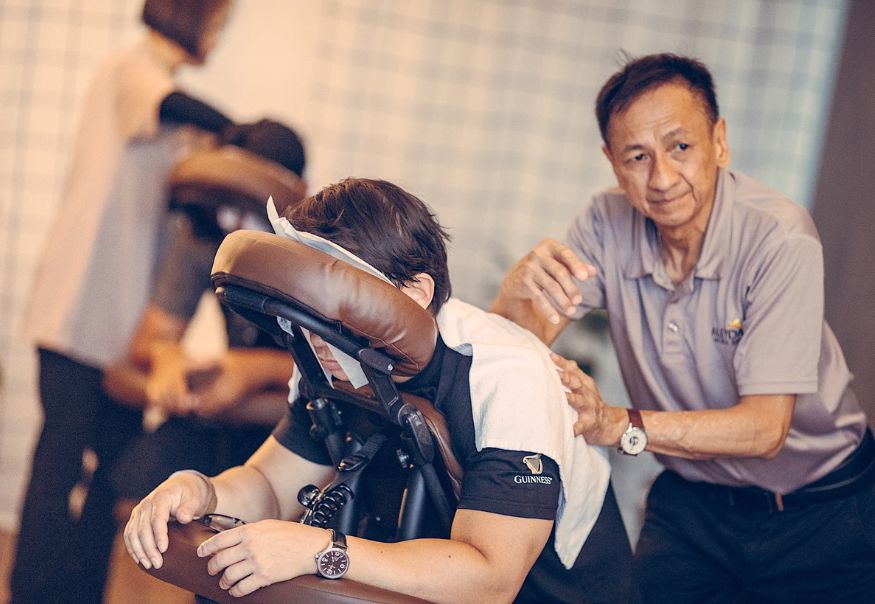Picture this: An employee takes a 15-minute massage break during a hectic workday. The stress eases, tension melts away, and they return to their desk feeling sharper, calmer, and more productive.
That’s not a luxury; it’s a strategic wellness investment. In today’s fast-paced environment, workplace massage is becoming an essential component of corporate wellness programs, delivering measurable benefits to both employees and employers.
Stress Reduction & Mental Clarity
Stress is one of the biggest workplace productivity killers. Massage therapy has been scientifically shown to:
- Reduce stress hormones and trigger endorphins.
- Improve focus and concentration, helping employees think clearly.
- Lower anxiety, which translates into calmer, more resilient teams.
Even the anticipation of a scheduled workplace massage session can lift moods and decrease workplace tension, creating a ripple effect across the office.
Preventing and Relieving Musculoskeletal Issues
Modern office life often means sitting for long hours, leading to back, neck, and shoulder pain. Office massage directly addresses these problems by:
- Relieving muscle tension caused by poor posture.
- Improving circulation and joint mobility.
- Reducing the risk of repetitive strain and ergonomic injuries.
This not only benefits employees’ health but also cuts down on costly medical claims for employers.
Immediate Productivity and Cognitive Benefits
Unlike some wellness activities that require long-term participation, workplace massage offers immediate returns. Employees often report:
- Feeling recharged and alert right after a session.
- Enhanced creativity and problem-solving ability.
- Reduced “mental fog” that comes with fatigue.
That short chair massage during lunch might be the key to better decision-making in the afternoon meeting.
Boosting Engagement, Morale & Retention
Wellness programs that include massage send a powerful message: our people matter. This has a direct impact on:
- Morale – employees feel cared for and supported.
- Engagement – healthier employees are naturally more invested in their work.
- Retention – workers are more likely to stay with companies that value their well-being.
A simple workplace massage initiative can be the differentiator between a workplace that drains employees and one that sustains them.
The ROI Employers Can’t Ignore
Wellness programs aren’t just good for employees, they’re a smart business investment. Research consistently shows:
- For every $1 spent, employers save $3–6 through reduced healthcare costs and absenteeism (Baicker, Cutler and Song, 2010).
- Johnson & Johnson famously saved $250 million in healthcare costs over six years by implementing employee wellness initiatives.
- Reduced absenteeism translates into a more consistent, productive workforce (Reddy et al., 2024)
Workplace massage, as a highly desirable wellness benefit, amplifies these financial gains.
Versatile, Accessible & Enjoyable
One reason massage stands out in workplace wellness is its universal appeal:
- Almost everyone enjoys a massage, ensuring high participation.
- Its flexibility in offering on-site chair massage, mobile therapist sessions, or rotating wellness days.
- Employees can benefit in just 15–20 minutes, making it easy to fit into busy schedules.
This makes it one of the most practical and popular wellness perks available.
Implementation Tips for HR Leaders
Rolling out a workplace massage program doesn’t have to be complicated. Best practices include:
- Regular sessions – not one-off perks, but scheduled offerings for sustained benefits.
- Customization – tailor frequency and duration to employee needs.
- Cultural alignment – leadership should participate and normalize taking wellness breaks.
- Feedback loops – gather employee input to refine the program.
Addressing Skepticism
Some critics argue that wellness programs can overpromise. The difference with workplace massage is that it’s backed by evidence: reduced stress, pain relief, and measurable health improvements.
That said, workplace massage should be part of a comprehensive wellness approach and also complement fitness initiatives, nutrition programs, and mental health support.
Massage in the workplace isn’t just about relaxation. It’s about health, productivity, retention, and ROI.
By adding massage to your wellness program, you’re investing in:
- Happier, healthier employees.
- Lower absenteeism and healthcare costs.
- A stronger, more engaged company culture.
It’s time for HR leaders and decision-makers to rethink wellness. The next step? Pilot a workplace massage program and measure its impact and you might be surprised how quickly the benefits show.
Whether your business is big or small, Aleyda Mobile Spa can design a corporate wellness program that fits your unique needs. We provide efficient and effective therapeutic massages that alleviate common musculoskeletal aches and pains, bringing stress relief and productivity straight to your workplace.
Book with Aleyda Mobile Spa today and give your team the wellness boost they deserve.
References
Baicker, K., Cutler, D. and Song, Z. (2010). Workplace Wellness Programs Can Generate Savings. Health Affairs, 29(2), pp.304–311. doi:https://doi.org/10.1377/hlthaff.2009.0626.
S. Jyothirmaye Reddy, Parag Kalkar, Ajay P Singh, Meenakshi Sharma, Poyam Sharma (2024). Investigate the Effectiveness of Employee Wellness Programs in Reducing Absenteeism, Improving Morale, And Enhancing Overall Organizational Culture. doi:https://doi.org/10.52783/jier.v4i2.889.
Frequently Asked Questions
Chair massages are the most popular. It’s quick, accessible, and non-disruptive.
Bi-weekly or monthly sessions are effective, but even quarterly offerings provide value.
On average, wellness programs return $3 to 6 per dollar spent, and massage enhances participation rates, amplifying results.
Yes, with Aleyda Mobile Spa, it is possible to serve both small startups and large corporations.








